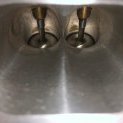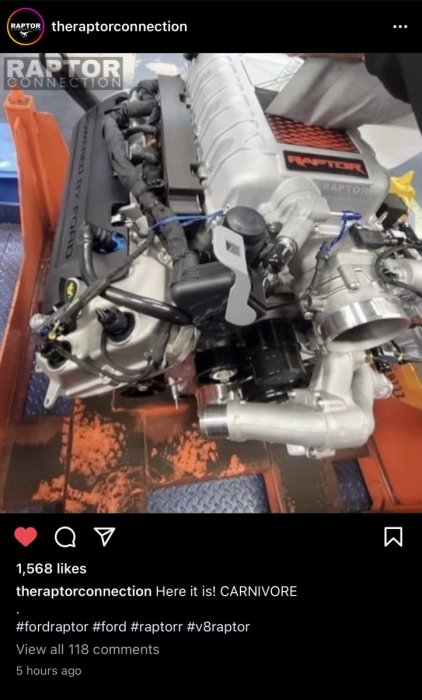-
Posts
214 -
Joined
-
Last visited
-
Days Won
2
Content Type
Profiles
Forums
Gallery
Downloads
Store
Everything posted by ESP08
-

Wards 10 Best Interiors for '22
ESP08 replied to ANTAUS's topic in Ford Motor Company Discussion Forum
Exactly -
We seem to be beyond the if phase of that discussion The 6.8 really doesn't seem to make much sense in the lineup at this point.
-

Raptor R Confirmed with 5.2L V8
ESP08 replied to Sherminator98's topic in Ford Motor Company Discussion Forum
There's no such things as too much HP as long as people are willing to pay for it -

Raptor R Confirmed with 5.2L V8
ESP08 replied to Sherminator98's topic in Ford Motor Company Discussion Forum
Yes. I missed a tall deck Coyote and/or a multivalve 6.2 (or 6.2-based) engine. -

Raptor R Confirmed with 5.2L V8
ESP08 replied to Sherminator98's topic in Ford Motor Company Discussion Forum
Also my first mod for a desert runner regardless of engine type or power adder would be a Powercore style filter. -

Raptor R Confirmed with 5.2L V8
ESP08 replied to Sherminator98's topic in Ford Motor Company Discussion Forum
When the Raptor R runs off and leaves the TRX for dead in those YouTube drag races (which it will) nobody will care about displacement. -

Raptor R Confirmed with 5.2L V8
ESP08 replied to Sherminator98's topic in Ford Motor Company Discussion Forum
Unless the 6.8 is either 4-valve or opposed valve, IDC. -

Raptor R Confirmed with 5.2L V8
ESP08 replied to Sherminator98's topic in Ford Motor Company Discussion Forum
It didn't get the 7.3, hooray. -

Wards 10 Best Interiors for '22
ESP08 replied to ANTAUS's topic in Ford Motor Company Discussion Forum
I've read a lot about Design Thinking actually... I'm glad Hackett is gone. -

Wards 10 Best Interiors for '22
ESP08 replied to ANTAUS's topic in Ford Motor Company Discussion Forum
I'll go ahead an say it, Design Thinking is management gobbledygook. -

Wards 10 Best Interiors for '22
ESP08 replied to ANTAUS's topic in Ford Motor Company Discussion Forum
Is a press release the extent of your evidence of Hackett's amazing influence on Ford's interior design? -

Wards 10 Best Interiors for '22
ESP08 replied to ANTAUS's topic in Ford Motor Company Discussion Forum
Yeah, I'm sure the CEO was real hands on with interior design -
The thing is GM power is always going to be cheaper. Turbocharged junkyard 5.3s will remain popular regardless of what Ford or anyone else does. They are just too plentiful, have a decent OE connecting, a decent OE cylinder head and that's usually the starting point from which most LS swap builds grow into something more serious (and expensive). But Ford has the ability to offer a thoroughly superior alternative as their parting shot here and it will be wildly attractive for those willing to pay to play. I really wish they would take it. I did follow Don and Project 777 closely as it happened, cool story.
-
Stray Kat, I'm not trying to argue either. Notice I am not attacking your positions at all, I am only offering my perspective on the topic. In my view, Ford's last performance engine being a pushrod engine is an admission of defeat. It's a slap in the face to all of the people that have pushed the Modular/Coyote to be the 2nd most popular late-model engine performance architecture. The Coyote after-market has gotten pretty huge and it is definitely the #2 most common swap project going. The Coyote's only weakness is displacement capacity but take that away and the debate is over for all time. It's been so frustrating for me to see the Boss architecture just sitting there begging for the Coyote treatment. ? That's how Ford goes out with a bang with a giant middle finger to the GM-fans; IMO, just take away the Coyote's only weakness. The Godzilla absolutely makes sense for a 5500 rpm truck engine. Lower cost, less size. I get it. But a performance engine? The Coyote has been legitimate competition for the LS/LT in virtually every class they both compete in in spite of being typically down by 50-100 cubic inches to the LS/LT. The Coyote is actually beating up the LS in Ultra Street. The way I see it the formula is pretty simple: Coyote + Boss = best domestic performance V8 architecture ever.
-
I agree the Coyote is the best Ford engine ever produced -- but just imagine the Coyote with the Boss's bore spacing/displacement capacity.
-
I suggest you make a trip to Mod Nationals one year and see what can be achieved in spite of bore spacing limitations thanks to multi-valve cylinder heads. Not all hot-rodders are scared of multiple cams and valves; in fact that's all that interests me to build. I am utterly bored by LSs. I think spec racing will always default to LS because of their prevalence and I don't think any architecture launched at this point will change that. IMO, a multi-valve engine with displacement potential will force a realignment of most hot rodder's expectations and perceptions.
-
I would prefer an alloy block multi-valve V8. Ford can never put GM in their place by following their LS/LT path; which is all a Godzilla-based 6.8 can ever be -- an also-ran, a shining example of too little too late, an LS/LT wannabe. A Godzilla-based 6.8 will offer no notable architectural advantages over the LS/LT and will never have the production volume to displace the LS as the common swap project or to incentivize aftermarket development like the LS/LT enjoys. You can't beat GM at their own game when they've had a 25 year head start. If Ford wants to go out with a bang and put GM in their place they should double-down on the path they set out on with the Modular. Combine everything they've learned over the last 3 decades with the Modular/Coyote and pair it with that 4.53" Boss/Godzilla bore spacing. Finally give the Modular fans what they've been asking for. This path can leave every OEM pushrod architecture ever devised in the dust, and that includes the big blocks.
-
The 570 HP crate LS7 has an utterly massive cam by OE standards. 227/242 @ .050" -- you'll never, ever see a production engine with .050" duration figures anywhere near that. The production 505 HP/485 TQ LS7 is more in-line with where a production Godzilla based 6.8 will fall; IMO, give or take 10-30 HP. A 32-valve 6.8 with power density similar to the Gen 3 Mustang 5.0 will land @ about 630 HP, 570 lb-ft (or 650 hp with GT350 style short runner intake). The torque curve of such an engine would make virtually everyone forget about the LT6.
-
It'll need 550+ HP N/A (or come factory boosted) to have a shot at legend status in today's environment, IMO. If it's a slightly warmed over 7.3 @ 6.8 liters it will most likely make less than the 5.2 Voodoo w/o electric assist.
-

Ford wins Daytona, but does Toyota own NASCAR?
ESP08 replied to Joe771476's topic in Ford Motor Company Discussion Forum
I'm not sure exactly what year they changed over the standardized small block architecture but manufacturers were running their own production or low-production specialty engines in NASCAR up until at least 1971 from what I can find. The Boss 429's Hemi was put into the Boss 429 Mustang just to meet NASCAR production requirements. I remember Doug Yates was floating the idea of running production based 4-valve Modular in NASCAR (after building some for FIA and LeMans) but NASCAR obviously eventually scoffed at any semblance of change. Fuel Injection in NASCAR? Whatever Detroit is selling on the NASCAR tour this season, it's certainly not cars, and it's certainly not engines. NASCAR's common-template creation has almost nothing in common with anything on the street. Every piece of a Winston Cup car now is specially made. And when was the last time anyone bought a [New] passenger car with a 358-c.i. engine with a carburetor? Nevertheless, Detroit's presence in NASCAR is huge. And if the men in the suits in the suites of America's car capital are really paying attention to what's going on down here, and not simply laying out new full-page ads celebrating victory in USA Today, then Detroit's presence may soon be getting bigger. Why? Toyota. So is that why Ford's Robert Yates is suddenly so interested in pushing NASCAR to approve a new, exotic race engine? Yates, the legendary engine builder and #38/88 car owner, is talking about NASCAR's need for a new-generation engine. The two current designs used on the Winston Cup tour are based on the 1955 Chevrolet V-8 small block and the 1969 Ford 351 small block. What Yates has been working on would be radical departure from those carburetor motors: A four-valve, double-overhead cam 4.6 liter. One of his motors just ran in the 24 Hours of Daytona, and, Yates said, "These things would do fine right here today," referring to the Winston Cup tour. "They make all the horsepower we need or more, at considerably less cost. And it's been enlightening for me to work on them," Yates said. "We felt proud in the 1960s and early 1970s that some of our technology went back to the manufacturers. But since then we've really sort of disconnected. There's not much stock about our engines. I feel like we're just working on dinosaurs. There is a lot of technology we use on the engines today, and I don't want anybody to think we're running with 1955 technology. But I just think we can accomplish the same thing with something that's built by the manufacturer. That's when the price comes down. Despite the expected dubious reaction from NASCAR executives to such an exotic piece, Yates said, "It would actually give them better control over what's going on." Yates said he talked with NASCAR officials last month during the 24 Hours, and he says he felt he sold Gary Nelson, NASCAR's director of competition, on part of the concept. Yates suggests that NASCAR might consider approving the engine for the tour's four restrictor- plate races, "because that's an engine program of its own. It would be a good place to introduce this engine.(Full story at the Winston Salem Journal)(2-20-2003) -

Ford wins Daytona, but does Toyota own NASCAR?
ESP08 replied to Joe771476's topic in Ford Motor Company Discussion Forum
Huh? NASCAR originally ran regular production engines then later allowed "specialty" low production engines which were all OEM designed and produced.



